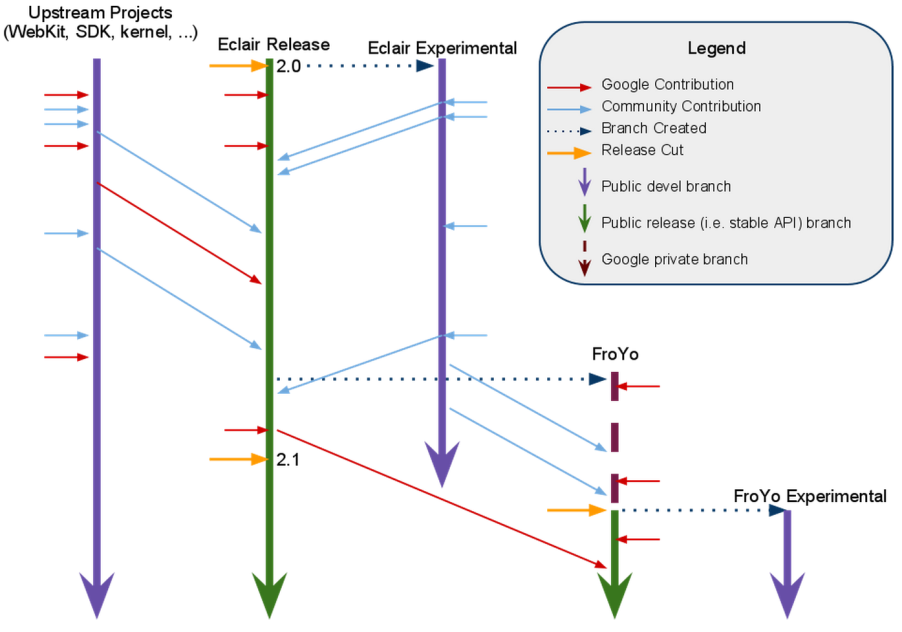The Android Open Source Project maintains a complete software stack intended to be ported by OEMs and other device implementors to run on actual hardware. Accordingly, we maintain a number of "code lines" to clearly separate the current stable version of Android from unstable experimental work.
The chart below depicts at a conceptual level how AOSP manages code and releases. We're referring to these as "code lines" instead of "branches" simply because at any given moment there may be more than one branch extant for a given "code line". For instance, when a release is cut, sometimes that will become a new branch in git, and sometimes not, based on the needs of the moment.

Notes and Explanations
- A release corresponds to a formal version of the Android platform, such
as 1.5, 2.1, and so on. Generally speaking, a release of the platform
corresponds to a version of the
SdkVersionfield used in AndroidManifest.xml files, and defined inframeworks/base/apiin the source tree. - An upstream project is an open-source project from which the Android stack is pulling code. These include obvious projects such as the Linux kernel and WebKit, but over time we are migrating some of the semi-autonomous Android projects (such as Dalvik, the Android SDK tools, Bionic, and so on) to work as "upstream" projects. Generally, these projects are developed entirely in the public tree. For some upstream projects, development is done by contributing directly to the upstream project itself. See Upstream Projects for details. In both cases, snapshots will be periodically pulled into releases.
- The diagram refers to "Eclair" and "FroYo"; however, they are simply placeholders, and the diagram actually reflects the overall release and branching strategy.
- At all times, a release code-line (which may actually consist of more than one actual branch in git) is considered the sole canonical source code for a given Android platform version. OEMs and other groups building devices should pull only from a release branch.
- We will set up "experimental" code-lines to capture changes from the community, so that they can be iterated on, with an eye toward stability.
- Changes that prove stable will eventually be pulled into a release branch. Note that this will only apply to bug fixes, app improvements, and other things that do not affect the APIs of the platform.
- Changes will be pulled into release branches from upstream projects (including the Android "upstream" projects) as necessary.
- The "n+1"th version (that is, next major version of the framework and platform APIs) will be developed by Google internally. See below for details.
- Changes will be pulled from upstream, release, and experimental branches into Google's private branch as necessary.
- When the platform APIs for the next version have stabilized and been fully
tested, Google will cut a release of the next platform version. (This
specifically refers to a new
SdkVersion.) This will also correspond to the internal code-line being made a public release branch, and the new current platform code-line. - When a new platform version is cut, a corresponding experimental code-line will be created at the same time.
About Private Code-Lines
The source management strategy above includes a code-line that Google will keep private. The reason for this is to focus attention on the current public version of Android.
OEMs and other device builders naturally want to ship devices with the latest version of Android. Similarly, application developers don't want to deal with more extant platform versions than strictly necessary. Meanwhile, Google retains responsibility for the strategic direction of Android as a platform and a product. Our approach is based on focusing on a small number of flagship devices to drive features, and secure protections of Android-related intellectual property.
As a result, Google frequently has possession of confidential information of third parties, and we must refrain from revealing sensitive features until we've secured the appropriate protections. Meanwhile, there are real risks to the platform arising from having too many platform versions extant at once. For these reasons, we have structured the open-source project -- including third-party contributions -- to focus on the currently-public stable version of Android. "Deep development" on the next version of the platform will happen in private, until it's ready to become an official release.
We recognize that many contributors will disagree with this approach. We respect that others may have a different point of view; however, this is the approach that we feel is best, and the one we've chosen to implement.
